Related Research Articles

The Duchy of Carinthia was a duchy located in southern Austria and parts of northern Slovenia. It was separated from the Duchy of Bavaria in 976, and was the first newly created Imperial State after the original German stem duchies.

Meinhard I, a member of the House of Gorizia (Meinhardiner), was Count of Gorizia from 1231 and Count of Tyrol from 1253 until his death.

Saint Paul's Abbey in Lavanttal is a Benedictine monastery established in 1091 near the present-day market town of Sankt Paul im Lavanttal in the Austrian state of Carinthia. The premises centered on the Romanesque monastery church were largely rebuilt in a Baroque style in the 17th century.

Viktring Abbey is a former Cistercian monastery in the Austrian state of Carinthia. Stift Viktring is now the name of the Roman Catholic parish in Viktring, since 1973 a district of the Carinthian capital Klagenfurt.
Henry IV was Duke of Carinthia and Margrave of Verona from 1122 until his death. He was the first ruler of those territories from the Rhenish House of Sponheim.

The Marchof Carniola was a southeastern state of the Holy Roman Empire in the High Middle Ages, the predecessor of the Duchy of Carniola. It corresponded roughly to the central Carniolan region of present-day Slovenia. At the time of its creation, the march served as a frontier defense against the Kingdoms of Hungary and Croatia.
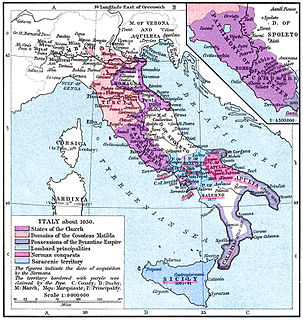
The March of Verona and Aquileia was a vast march of the Holy Roman Empire in northeastern Italy during the Middle Ages, centered on the cities of Verona and Aquileia. Seized by King Otto I of Germany in 952, it was held by the Dukes of Bavaria; from 976 in personal union with the Duchy of Carinthia. The margravial regime ended with the advent of the Lombard League in 1167.
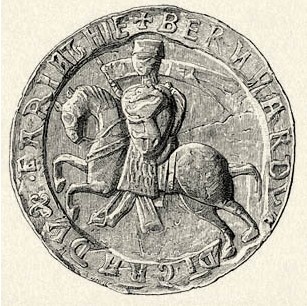
Bernhard von Spanheim, a member of the noble House of Sponheim, was Duke of Carinthia for 54 years from 1202 until his death. A patron of chivalry and minnesang, Bernhard's reign marked the emergence of the Carinthian duchy as an effective territorial principality.
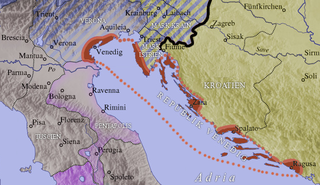
The March of Istria was originally a Carolingian frontier march covering the Istrian peninsula and surrounding territory conquered by Charlemagne's son Pepin of Italy in 789. After 1364, it was the name of the Istrian province of the Habsburg Monarchy, the Austrian Empire and Austria-Hungary.
Engelbert II, a member of the House of Sponheim, was Margrave of Istria and Carniola from about 1103/07 until 1124. In 1123, he succeeded his elder brother Henry as Duke of Carinthia and Margrave of Verona which he held until his retirement in 1135.
Sponheim or Spanheim was a medieval German noble family, which originated in Rhenish Franconia. They were immediate Counts of Sponheim until 1437 and Dukes of Carinthia from 1122 until 1269. A cadet branch ruled in the Imperial County of Ortenburg-Neuortenburg until 1806.
Engelbert III, a member of the Rhenish Franconian House of Sponheim, was Margrave of Istria from 1124 until his death.
Liutold of Eppenstein was Duke of Carinthia and Margrave of Verona from 1077 until his death.
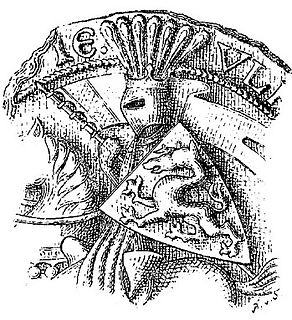
Ulrich III was the Lord in the March of Carniola from c. 1249 and Duke of Carinthia from 1256 until his death, the last ruler from the House of Sponheim. His rule had long-lasting consequences. In Carniola, he acquired the former Meranian possessions, thus becoming the first undisputed princeps terrae, provincial lord or landgrave, creating the power and legal basis of the future Duchy of Carniola. The center of his original Carniolan possessions, Ljubljana, became the new administrative center and thus the provincial capital, as well as the center of Ulrich's power. In Carinthia, which he took over after his father's death, his seal became the coat of arms of Carinthia up to today. Despite his attempts to secure the vast Babenberg inheritance through two marriages, first to Agnes of Merania, widow of the last Babenberg duke Frederick II of Austria, and then to Frederick's niece Agnes of Baden, Ulrich remained childless. After a short interregnum by his younger brother Philip of Spanheim, patriarch of Aquileia, the House of Spanheim went extinct, and all of Ulrich's possessions were inherited by his cousin Ottokar I of Bohemia.

Philip of Spanheim was elected Archbishop of Salzburg (1247–1257) and Patriarch of Aquileia (1269–1271). He held the title of a Count of Lebenau (1254–1279) and was nominal Duke of Carinthia. With his death the senior line of the House of Sponheim came to an end.

Pellegrino II was Patriarch of Aquileia in northern Italy from 1195 to 1204.
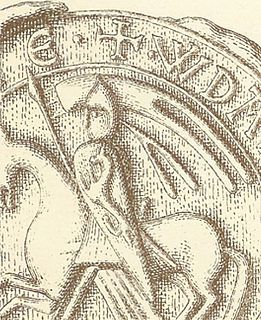
Ulrich II, a member of the House of Sponheim, was Duke of Carinthia from 1181 until his death. He was one of the noble Germans who took part in the Crusade of 1197.
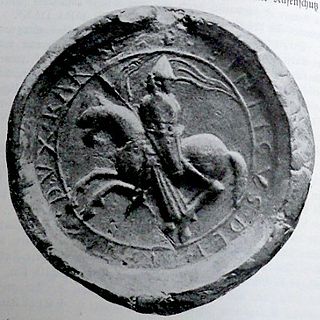
Henry V, of the House of Spanheim, was the margrave of Verona from 1144 until 1151 and the duke of Carinthia from 1144 to his death. According to the contemporary chronicler Otto of Freising, Henry was "a valiant man, experienced in the councils of war".
Ulrich I, of the House of Sponheim, was the Duke of Carinthia and Margrave of Verona from 1135 until his death. He was the eldest son of Duke Engelbert and Uta, daughter of Burggrave Ulrich of Passau, his namesake. His father abdicated in 1135 and Ulrich was appointed his successor by the Emperor Lothair II at an imperial diet being held in Bamberg.

The Mark an der Sann was a border march of the Holy Roman Empire, in the territory of present-day Slovenia. It was established in the second half of the 10th century to protect the Empire against its enemies to the east, especially from Hungarian raids.
References
- Cyrus, Cynthia J. (2013). Received Medievalisms: A Cognitive Geography of Viennese Women's Convents. Palgrave Macmillan.
- Loud, Graham A.; Schenk, Jochen, eds. (2017). The Origins of the German Principalities, 1100–1350: Essays by German Historians. Taylor & Francis.